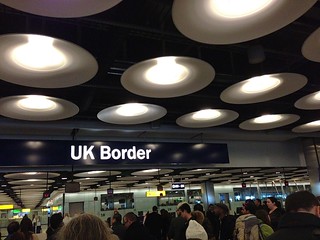Shoes
During my recent travels, I was lucky enough to encounter a security scheme that was distinctly post post-9/11 and rational.
Security at Toronto Pearson and London Heathrow did not make us remove our shoes.
At Pearson, it was because my family holds NEXUS passes, meaning we are pre-screened and designated as low-risk, trusted travelers. We flash the NEXUS card and get to cut the line, and when we arrive at screening, we were able to keep our shoes on. Oh, glorious day!
Although Heathrow made us remove iPads as well as laptops from our carryons, shoes could stay on there, too.
When approaching security at T5 at Heathrow, there were greeters at the entryway handing out free liter-sized ziploc bags for passengers to use for liquids. There were easily 20 open security lanes, all moving rapidly with minimal lines. The bins used for loose items were conveniently obtained via an automatic dispenser under the conveyor belt – not by having to go back for a mess of buckets for 4 people and their stuff.
But the shoes – not having to remove shoes makes a huge difference in terms of speed and at least perceived convenience.

